Celestial Monday
Double-click on any image to view it full size. Click the back-button to return to your place on this page.
Greetings!
Most of my favorite photographic subjects are rather small – typically only a few inches across. The most common exceptions are aircraft (or bridges), which may be a couple of hundred feet across. So let’s start today with an aircraft – a Virgin Atlantic 747 to be precise – shown in picture #1 – which is the only image in this set taken in daylight, and the moon appears bright because it reflecting the light of our sun to us!
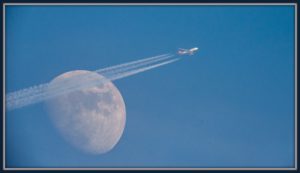
I would guess that the airliner was probably in the cruise phase of a flight to Florida, and is probably about six miles high, and further than that away from me (not to mention moving at several hundred miles per hour). However, the larger object in the picture is about two thousand miles across, and is about a quarter of a million miles away. The next picture, #2, includes four moons, the smallest of which is about the same size as our moon, plus their host planet, Jupiter.
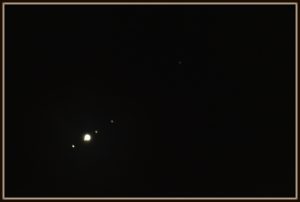
Jupiter actually has some fifty-three named moons (and possibly sixteen or more not yet named). The four largest ones, the ones in the picture, which have been known since the time of Galileo, are Ganymede, Io, Europa, and Callisto, and as far as I can determine they appear in that order from left to right in the picture, with Jupiter between Io and Europa. The distance from Earth to Jupiter varies as the two planets trace their respective orbits around the sun, but is never less than some 365 million miles. Even so, the light that makes Jupiter and its moons visible is still sunlight reflected back to us. This picture was taken from our condo window – all the others were taken at Topsail Island.
Picture #3 will probably be a little bewildering at first sight.
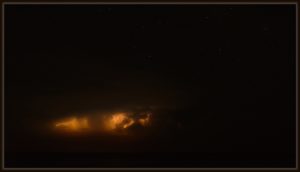
It was taken looking out over the ocean, and you can just make out the horizon close to the bottom edge of the image. About one quarter of the way across from the left-hand edge, and on the horizon, you can see a bright dot that is the flashing light on a navigational buoy a couple of miles off-shore. Above that you will see lightning bolts lighting-up the clouds of a thunderstorm that is many miles off-shore. And above that you will see stars shining in the clear sky. And now we are talking really big distances. The nearest star to our own sun is so far away that it takes more than four years for light, travelling at 186 thousand miles per second, to reach us. It is about 269 thousand times as far away from us as our sun is. All the stars in this picture are even further away than that. You probably will not recognize any of the stars in this image, but you will undoubtedly recognize at least some in the next picture.
I took picture #4 primarily to show the Big Dipper – Ursa Major – but, on subsequent inspection I was delighted to find that I had also caught the Little Dipper – Ursa Minor – and the Pole Star (Polaris).
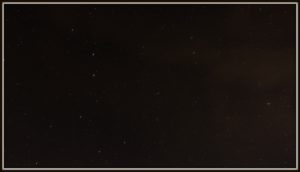
To help identification, picture #4a consists of a compressed copy of the main picture, and another copy with the outline of the Big Dipper (on the left side) and the Little Dipper (on the right), and I have also marked the Pole Star.
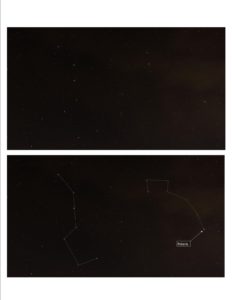
#5 was taken in an attempt to capture some of the magnificent sight of the Milky Way.
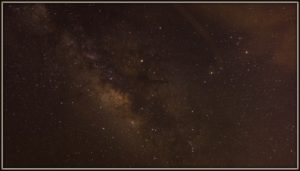
Making star pictures is an art unto itself, in which I am an absolute beginner, but when I sent these two images to an astronomer friend (for help in identifying what turned out to be the planet Saturn), he opined that they were nothing to be ashamed of, as a result of which I am offering them to you. Like #4 and #4a, I have prepared a “study guide”, #5a, to help you spot some of the interesting features in this image.
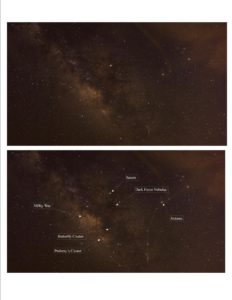
In addition to the Milky Way itself, and Saturn, the most notable feature is the entire constellation of Scorpius (or at least all the bright stars) as shown. The star Antares, the heart of the scorpion, gets its name from being considered, in antiquity, the rival (anti) of Mars (or Ares) on account of its reddish color. Antares is more than 600 light years from us. It is a red “super-giant” star, nearing the end of its life, having burned all its hydrogen. It is now shining by the light of fusing progressively heavier elements. It has a diameter 700 times that of our sun, meaning that if it were put in the place of our sun without disturbing anything else (obviously an impossibility), it would swallow up not only Earth’s orbit, but Mars’ as well. However, in spite of its huge size, its average density is less than one millionth of the sun’s, and it is also much cooler – hence its reddish color. I have labeled (in #5a) two clusters of stars. Ptolemy’s cluster actually takes up a larger apparent area of the sky than the full moon! Fortunately, on the night this picture (and #4) were taken, there was little or no moonlight, and there is much less light pollution at our beach than here in Northern Virginia, so the stars are easier to see. Even so, this shot required a 20 second exposure. This is long enough that, without putting the camera on a very sophisticated mounting, the Earth actually rotates enough during the exposure that the stars, instead of showing as perfect points of light, are actually recorded as short arcs, which you will notice if you zoom-in on #5. You have probably seen pictures in which the photographer deliberately extends the effective exposure over several hours, to give concentric star tracks. I have also labeled the “Dark Horse” feature. This was pointed out by my astronomer friend’s son, who explained it thus: “Saturn is right on the edge of a series of dark nebulae informally called the “dark horse.” In your photo imagine a standing horse but turned ninety degrees counter clockwise so its feet are to the right and its head is up. Saturn is right about where a saddle horn would fall.” Thank you Dick and Steve!
For the non-astronomers amongst you, a nebula is a cloud of dust that typically blocks light from stars behind it and hence appears darker than the surrounding areas. Also for the non-astronomers, my own crude explanation of the Milky Way is as follows. Our sun is just one of the one hundred thousand million stars that make up our galaxy. However, these stars are not just randomly distributed but rather form a disk with a bulge in the center. The central bulge – the nucleus – is about 20,000 light years in diameter. From it a set of spiral “arms” extend out to the edge of the disk, which is about 50,000 light years in radius. Our sun, and hence we ourselves, is located in one of those arms, about 30,000 light years from the center. But the arms are by no means perfectly flat, so when we look “up” at night, we see stars in all directions. However, if we look towards the center of the galaxy, then we see a far greater density of stars because we are looking along the plane of the disk. And the Milky Way is just the name that has been given to the rich field of stars we see as we look along the plane. The nucleus of our galaxy lies in the direction of Sagittarius, which is the constellation next to Scorpius, so that is where the very greatest concentration of stars – and hence the brightest part of the Milky Way – appears to lie. Virtually everything we can see with the naked eye is contained within our Galaxy. However, we now know that there are many other galaxies in the cosmos – at least 100 billion of them – of which ours is special only because it is the one in which we live. Until recently, the nearest galaxies were thought to be the Large and Small Magellanic Clouds, roughly 200,000 light years from our Galaxy. However, that honor is now held by the Canis Major Dwarf Galaxy, which was discovered in 2003 and is only 25,000 light years from the sun. It is being pulled apart by our galaxy’s gravity, as is the Sagittarius Dwarf Elliptical Galaxy, discovered in 1994, which is some 70,000 light years from the sun, but so arranged relative to us that some of its stars actually overlap with the Milky Way.
Coming back to Earth, the final picture, #6, was taken on a night when there was sufficient moonlight to give, with a 30 second exposure, a recognizably image of the beach.
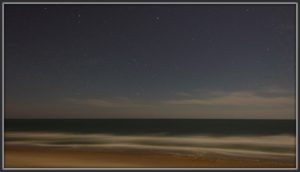
The bright spot half way across the horizon is the same navigational light as seen in #3, and you should also by now be able to identify some of the stars in Scorpius’ head, although they are rotated relative to #5, and are lower in the sky.
Have a great week!